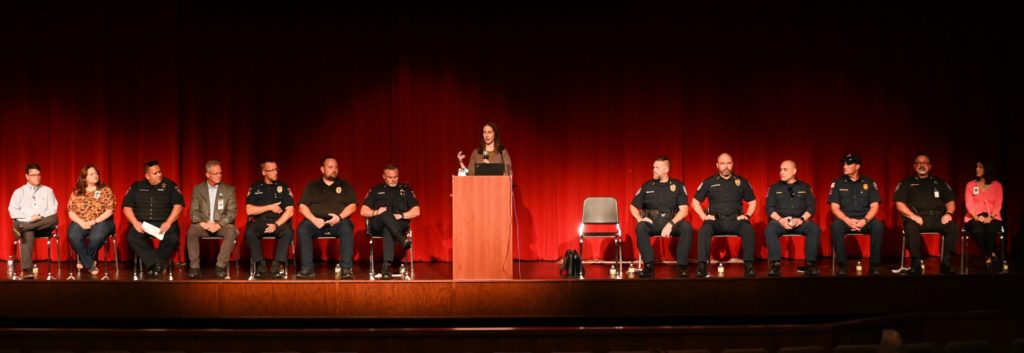In Leander ISD, the partnership between the district and parents serves as the foundation in benefiting students and keeping them safe. It takes all of us.
In response to community requests for educational awareness on topics of safety and security, along with health and wellness, we launched Empowering Parents.
Summit

In the fall of 2022, Leander ISD hosted the Empowering Parents Summit, pulling together district leaders and community partners to answer questions from our community about substance abuse, particularly the use of fentanyl, while also addressing concerns about campus safety and security.
Substance Abuse
Fentanyl Awareness
What is Fentanyl (and what is its Impact)?
- Fentanyl is a synthetic opioid that is 50–100 times more potent than morphine, often lethal with as little as 2 milligrams.
- Over 71,000 Americans died from fentanyl in 2021, an increase of 23 percent from the previous year.
- Over that same period, Texas saw an 89 percent increase in fentanyl-related fatalities, with provisional data showing 1,672 deaths in 2021 as compared to 883 in 2020.
- The United States Drug Enforcement Agency Laboratory has found that, of the fentanyl-laced fake prescription pills analyzed in 2022, six out of ten now contain a potentially lethal dose of fentanyl.
How to Recognize the Signs of an Overdose
- A person will appear to be unresponsive; may have irregular breathing; may appear gray, blue, or have pale skin color; and may have very small pupils.
What to do if you Suspect an Overdose
- Call 911 immediately or direct someone nearby to call and say that you are supporting a suspected overdose.
- Administer Naloxone. Even though the person is unresponsive: 1) announce that you are going to give naloxone 2) spray the naloxone in the person’s nose. To find out more information about Naloxone, visit the NIDA Naloxone Drug Facts page.
- Follow instructions of the 911 operator.
Additional Resources
- The United States Drug Enforcement Agency has a dedicated parent/guardian page with multiple resources available.
- The National Institute of Drug Abuse has created a resource of conversation starters about substance use and how to talk with teens about substance use.
- The Substance Abuse and Mental Health Services Administration has free Tips for Teens Fact Sheets available for download on a variety of topics.
Jessica Duncan Cance, MPH, PhD, shares a presentation titled “Drugs & Youth: What We All Need to Know.” In the presentation, Cance speaks on substance abuse, opioids, fentanyl, naloxone (Narcan).
Key Takeaways
- Teen brains are vulnerable
- Alcohol is still the most used substance
- Counterfeit pills are a threat
- Naloxone saves lives
- Alcohol and drug use is preventable
Resources
- National Institute on Drug Abuse (NIDA) website: What is Fentanyl
- Drug Enforcement Administration (DEA) website: One Pill Can Kill
- Center for Disease Control (CDC) video: Fentanyl
- National Institute on Drug Abuse (NIDA) website: Parent Conversation Starters
Campus Safety & Security
Leander ISD Risk Management Director Darla Humes and Security Director Russell Bundy share a presentation on safety and security within the district. In the presentation, Humes and Bundy speak to the proactive measures LISD takes to be ready in case of an emergency.
Community Partner Panel
A panel of community partners and district representatives answered questions from our community about substance abuse, particularly the use of fentanyl, while also addressing concerns about campus safety and security.
Index of Questions Asked of Panelists
Use the links below to jump directly to a specific question from the full panel discussion displayed above.
- The source of the questions asked
- Panelists introduction
- The partnership of law enforcement with Leander ISD from the law enforcement perspective
- The partnership of law enforcement with Leander ISD from the district’s perspective
- How are you keeping the school community safe?
- How does the district teach about substance abuse?
- We go through a lot of drills on our campuses. Do drills cause trauma?
- Do LISD students have access to Narcan (Naloxone)?
- For emergency responders, what has been your experience with Narcan (Naloxone)?
- Does LISD have trauma kits? And where are they located?
- How do we support mental health in the district?
- For emergency responders, what are you seeing in the community with regards to mental health and wellness?
- Can you share information about the door audits of district facilities?
- How do we address the security of portable buildings?
- In new facilities, some with walls of glass, how do we balance safety and security with these new learning environments?
- For emergency responders, how do you establish what is a credible threat?
- What can parents do to help their children avoid substance misuse or abuse?
- For law enforcement, how best do we equip our parents?
- Closing remarks
